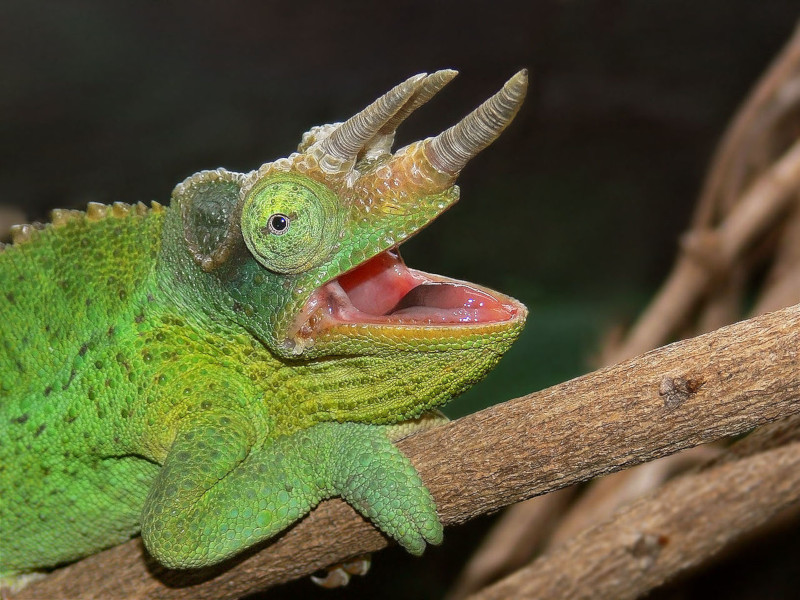
Jackson’s Chameleon Facts
- The term of Jackson’s Chameleon serves as just one of the common names for a particularly distinctive species of reptile. In fact, this remarkable creature actually remains known by quite a wide variety of common monikers. Some of these titles remain quite distinctive.
- Some of these alternate tags include such truly colorful names as the horned chameleon, Jackson’s Horned Chameleon, and even the Kikuyu three-horned chameleon. Its scientific name, however, remains that of the somewhat hard to pronounce Trioceros jacksonii.
- By either of these many names, though, it represents a truly fascinating animal. The highly renowned Belgian-British zoologist George Albert Boulenger made the first official recognition of it as a separate species. This formal acknowledgement occurred in the year 1896.
- Quite fortunately, for the moment, at least, its population appears to be remaining both stable and sufficient. This further holds true throughout the entirety of its range. As a result, the IUCN currently lists it as Least Concern on its published Red List of Threatened Species.
- The marvelous Jackson’s Chameleon nonetheless faces several potential threats to its continued existence as a species. One of these dangers involves the presence of invasive species in its native range. Its greatest threat, though, no doubt consists of climate change.
Related Articles
Jackson’s Chameleon Physical Description
It bears noting that, while the fascinating Jackson’s Chameleon truly impresses those fortunate enough to enocunter one, it does not do so due to sheer size. Somewhat surprisingly to some, this specific reptile only ranks as a roughly average-sized species among its many relatives in its Order.
This wonder of Nature and evolution does, however, amaze the viewer in other ways. For one, the animal displays the physiological trait of sexual dimorphism in not one, but two separate ways. Although not unknown, this degree of gender-based differentiation remains uncommon.
In terms of overall size, the males of the species attain respectably greater average measurements than their female counterparts. He reaches an average head-to-tail length of roughly 15 in (38 cm). She, meanwhile, only grows to an average total length measuring roughly 10 in (25 cm).
The second manifestation of the sex-based differences develops in regards to the presence of horns. The male actually develops three of these horns, generally showing brown in color. Females of the creature, on the other hand, possess no horns at all, distinguishing themselves significantly.
In coloring, though, both genders of the fabulous Jackson’s Chameleon develop essentially the same appearance. This pattern evolved as somewhat changeable, however. The principal color usually presents as a very bright green, with some shades of yellow or blue, though this changes.
- Kingdom: Animalia
- Phylum: Chordata
- Class: Reptilia
- Order: Squamata
- Family: Chamaeleonidae
- Genus: Triceros
- Species: T. jacksonii
Jackson’s Chameleon Distribution, Habitat, and Ecology
Despite the fact that it’s now been spread by the actions of man to other parts of the world, the Jackson’s Chameleon evolved as native to only a small are of the globe. More specifically, it develop as endemic to portions of what’s now the two countries of Tanzania and Kenya, in Africa.
Now, though, the intriguing animal appears in the wild in several other regions of the globe. Through the recklessness of humans it now inhabits, in small numbers, portions of the Hawaiian Islands and Florida, in the United States. Unconfirmed reports of sightings in other areas also exist.
Wherever it appears, the distinct reptile habitually proves itself to be reasonably flexible in terms of its specific habitat. In its natural range, the creature lives at altitudes between 5,250 -8,010 ft (1,600 – 2,440 m). In Hawaii, however, it now appears at heights between 330 – 3,280 ft (100 – 1,000 m).
Within all these places, though, the intrepid Jackson’s Chameleon apparently prefers to make its home in regions of local forests and woodlands. It further requires these various areas to possess ample amounts of rainfall, as well as temperate to tropical temperature ranges for its survival.
Just as its many close relatives, it evolved as purely carnivorous in nature. For this, its adaptive camouflage serves it perfectly, It primarily consumes large quantities of various insects, such as isopods, millipedes, spiders, centipedes, snails, and sometimes even other small lizards.
This marvel also distinguishes itself in yet one more extraordinary manner. Most chameleons lay eggs, but not this one. This species gives live birth, typically to between 8 – 30 young. Interestingly, while most related creatures are highly territorial, this one typically remains much less so.
Species Sharing Its Range
Check out our other articles on 5 Marvelous Mammals of Central America, Pesquet’s Parrot, Christmas Island, Purple Passionflower, Green Sawfish, Indian Giant Squirrel, Blue-lipped sea krait
